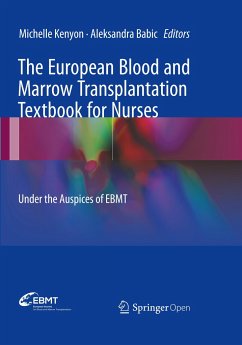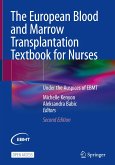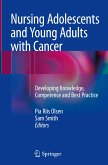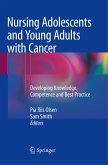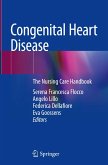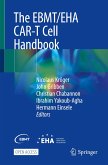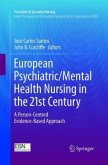The European Blood and Marrow Transplantation Textbook for Nurses
Under the Auspices of EBMT
Herausgegeben:Kenyon, Michelle; Babic, Aleksandra
The European Blood and Marrow Transplantation Textbook for Nurses
Under the Auspices of EBMT
Herausgegeben:Kenyon, Michelle; Babic, Aleksandra
- Broschiertes Buch
- Merkliste
- Auf die Merkliste
- Bewerten Bewerten
- Teilen
- Produkt teilen
- Produkterinnerung
- Produkterinnerung
This book is open access under a CC BY 4.0 license.
This textbook, endorsed by the European Society for Blood and Marrow Transplantation (EBMT), provides adult and paediatric nurses with a full and informative guide covering all aspects of transplant nursing, from basic principles to advanced concepts. It takes the reader on a journey through the history of transplant nursing, including essential and progressive elements to help nurses improve their knowledge and benefit the patient experience, as well as a comprehensive introduction to research and auditing methods. This new volume…mehr
Andere Kunden interessierten sich auch für
![The European Blood and Marrow Transplantation Textbook for Nurses The European Blood and Marrow Transplantation Textbook for Nurses]() The European Blood and Marrow Transplantation Textbook for Nurses41,99 €
The European Blood and Marrow Transplantation Textbook for Nurses41,99 €![Nursing Adolescents and Young Adults with Cancer Nursing Adolescents and Young Adults with Cancer]() Nursing Adolescents and Young Adults with Cancer33,99 €
Nursing Adolescents and Young Adults with Cancer33,99 €![Wound Care Education in Nursing: A European Perspective Wound Care Education in Nursing: A European Perspective]() Wound Care Education in Nursing: A European Perspective41,99 €
Wound Care Education in Nursing: A European Perspective41,99 €![Nursing Adolescents and Young Adults with Cancer Nursing Adolescents and Young Adults with Cancer]() Nursing Adolescents and Young Adults with Cancer33,99 €
Nursing Adolescents and Young Adults with Cancer33,99 €![Congenital Heart Disease Congenital Heart Disease]() Congenital Heart Disease33,99 €
Congenital Heart Disease33,99 €![The EBMT/EHA CAR-T Cell Handbook The EBMT/EHA CAR-T Cell Handbook]() The EBMT/EHA CAR-T Cell Handbook33,99 €
The EBMT/EHA CAR-T Cell Handbook33,99 €![European Psychiatric/Mental Health Nursing in the 21st Century European Psychiatric/Mental Health Nursing in the 21st Century]() European Psychiatric/Mental Health Nursing in the 21st Century60,99 €
European Psychiatric/Mental Health Nursing in the 21st Century60,99 €-
-
-
This book is open access under a CC BY 4.0 license.
This textbook, endorsed by the European Society for Blood and Marrow Transplantation (EBMT), provides adult and paediatric nurses with a full and informative guide covering all aspects of transplant nursing, from basic principles to advanced concepts. It takes the reader on a journey through the history of transplant nursing, including essential and progressive elements to help nurses improve their knowledge and benefit the patient experience, as well as a comprehensive introduction to research and auditing methods. This new volume specifically intended for nurses, complements the ESH-EBMT reference title, a popular educational resource originally developed in 2003 for physicians to accompany an annual training course also serving as an educational tool in its own right.
This title is designed to develop the knowledge of nurses in transplantation. It is the first book of its kind specifically targeted at nursesinthis specialist field and acknowledges the valuable contribution that nursing makes in this area. This volume presents information that is essential for the education of nurses new to transplantation, while also offering a valuable resource for more experienced nurses who wish to update their knowledge.
This textbook, endorsed by the European Society for Blood and Marrow Transplantation (EBMT), provides adult and paediatric nurses with a full and informative guide covering all aspects of transplant nursing, from basic principles to advanced concepts. It takes the reader on a journey through the history of transplant nursing, including essential and progressive elements to help nurses improve their knowledge and benefit the patient experience, as well as a comprehensive introduction to research and auditing methods. This new volume specifically intended for nurses, complements the ESH-EBMT reference title, a popular educational resource originally developed in 2003 for physicians to accompany an annual training course also serving as an educational tool in its own right.
This title is designed to develop the knowledge of nurses in transplantation. It is the first book of its kind specifically targeted at nursesinthis specialist field and acknowledges the valuable contribution that nursing makes in this area. This volume presents information that is essential for the education of nurses new to transplantation, while also offering a valuable resource for more experienced nurses who wish to update their knowledge.
Produktdetails
- Produktdetails
- Verlag: European Society for Blood and Marrow Transplantation (EBMT) / Springer / Springer International Pub
- Artikelnr. des Verlages: 978-3-030-09591-8
- Softcover reprint of the original 1st ed. 2018
- Seitenzahl: 332
- Erscheinungstermin: 1. Februar 2019
- Englisch
- Abmessung: 254mm x 178mm x 17mm
- Gewicht: 702g
- ISBN-13: 9783030095918
- ISBN-10: 3030095916
- Artikelnr.: 55431033
- Herstellerkennzeichnung Die Herstellerinformationen sind derzeit nicht verfügbar.
- Verlag: European Society for Blood and Marrow Transplantation (EBMT) / Springer / Springer International Pub
- Artikelnr. des Verlages: 978-3-030-09591-8
- Softcover reprint of the original 1st ed. 2018
- Seitenzahl: 332
- Erscheinungstermin: 1. Februar 2019
- Englisch
- Abmessung: 254mm x 178mm x 17mm
- Gewicht: 702g
- ISBN-13: 9783030095918
- ISBN-10: 3030095916
- Artikelnr.: 55431033
- Herstellerkennzeichnung Die Herstellerinformationen sind derzeit nicht verfügbar.
Michelle Kenyon works as the Elimination of Leukaemia Fund (ELF) Post BMT Clinical Nurse Specialist at King's College Hospital London. She has worked for more than 25 years in the field of Haemato-oncology and Stem Cell Transplantation. Her interest in improving the patient experience of Haematopoietic Stem Cell Transplantation (HSCT) led her to write "The Seven Steps", a patient information book (2002) and subsequently the "Next Steps" (2012). Around 50,000 copies of these titles have been distributed, and are now used as the basis of informed consent for transplant recipients throughout the UK. She studied her BSc in Cancer Nursing and MSc in Advancing Cancer Nursing Practice at King's College London, and undertook an empirical research study exploring the use of Life-coaching in Stem Cell Transplant Survivors for her dissertation. She supports patients throughout their post-transplant recovery and has a particular interest in survivorship issues and the effects of treatment. She launched the HSCT long-term follow-up clinic at King's College Hospital in 2014 and has found the patient insights inspiring and the overall experience highly rewarding. She is the nurse representative on the BSBMT executive, Vice Chair EBMT (UK) NAP group and is Secretary of the EBMT NG. Aleksandra Babic is a nurse manager, affiliate to Oncology Institute of Southern Switzerland (IOSI), in Bellinzona, as Transplant Unit Coordinator and Quality manager. She received her nurse diploma from the College Center of Professional Formation in Dubrovnik, Croatia, in 1988, and was awarded a Master's degree in Nurse Management in 2006. Until 2016 she worked as a nurse manager in apheresis unit at IEO, European Institute of Oncology in Milan and has published papers on peripheral blood stem cell collection and mobilization (i.e. R-ESHAP plus pegfilgrastim as an effective peripheral stem cell mobilization regimen for autologous stem-cell transplantation in patients with relapsed/refractory diffuse large B-cell lymphoma. Transfus Apher Sci. 2013. Successful mobilisation of peripheral blood stem cells in children using plerixafor: a case report and review of the literature. Blood Transfus. 2013. Who should be really considered as a poor mobilizer in the plerixafor era? Transfus Apher Sci. 2012 ) and photopheresis (i.e. Efficacy of photopheresis extracorporeal procedure as single treatment for severe chronic GVHD: A case report', Transfusion and Apheresis Science, 2013). In addition, Aleksandra has presented at a number of conferences worldwide, most recently including the GIIMA 3rd National Conference, GITMO and the EBMT 2015 conference: Validation of PBSC collection within JACIE program: A multicenter evaluation. From 2016 she is also a Jacie Quality Manager Inspector.Aleksandra is the former EBMT NG President (European Blood and Marrow Transplant Society) Nurses Group, which includes more than 800 nurses in 64 countries worldwide. She is a former President of GIIMA, the Italian Nurses Group in Mobilisation and Aphaeresis, and the founder and a board member of the not-for-profit association, Nurses No Frontiers.
Forward. Brief history of EBMT/EBMT Nurses group. Where we are now. Where we are going.- Introduction. HSCT nursing through the ages/the evolution of the HSCT nurse. Brief history of HSCT Nursing. Importance of HSCT nursing. Extended practice roles etc..- Chapter 1. JACIE & Quality management in HSCT - Implications for Nursing.- Chapter 2. HSCT: how does it work? What HSCT nurses need to know? Different types of transplant. FAQs.- Chapter 3. Donor selection. HLA typing. Selecting the right donor. Which transplant for which patient?.- Chapter 4. Transplant Preparation. The role of the transplant Co-ordinator. Information and consent. Role of risk assessment and comorbidity scores (HCTI/Karnofsky/Lansky etc.). Fertility preservationWork-up/ physical assessment. Venous access devices- principles of placement and care. Disease assessment. The advocacy roleof the HSCT nurse. Ethical dilemmas. Paediatric considerations.- Chapter 5. Cell source and Apheresis. Cell source: where do we get the cells from?. Basics of apheresis. Information and consent. Haematology in Apheresis/ mobilisation of stem cells. Adverse reactions. Vascular access. Donor care. Quality issues. Paediatric patients/donors and apheresis.- Chapter 6. Principles of Conditioning Therapy & Cell infusion. Chemotherapy. Radiotherapy. Immunotherapy. Cell infusion: procedures and nursing care. Paediatric considerations.- Chapter 7. BMT settings, Infections and infection control. Reverse Barrier Nursing and protective Isolation Ambulatory Care. Respiratory infectiosn and administration of therapy. Fungal infections and administration of therapyCommon viral complications. CMV. EBV-PTLD. Multiply resistant bacteria - reducing the spread. C-Diff. Hepatitis. Emerging infections (HepE). Paediatric considerations.- Chapter 8. Transplantation through the generations. Introduction. Brief outline of differences between Transplantation in child and the adult. Section 1: Transplanting the child. Special indications. Nursing considerations. Section 2: Transplanting the Young Adult/ AHA/ Adolescent. Special indications. Nursing considerations. Discuss the teen as a child vs adult. Discuss development of teen cancer centres. Section 3: Transplanting the adult. Nursing considerations. Section 4: Transplanting the older adult. Nursing considerations.- Chapter 9. Early and acute complications and the principles of HSCT Nursing Care. Mucositis and principles or oral care. Sepsis and principles of care. Transfusion. VOD. Haemorrhagic cystitis. Endothelial damage.- Chapter 10. Supportive Care of the HSCT recipient. Nursing assessment-vital signs and their significance/importance. Engraftment. The role of early warning scores. Assessment tools eg oral assessment, nutritional assessment. Principles of nutritional support. Skin care. Oral care. Psychological care. Physiotherapy and exercise. Therapeutic interventions eg complementary therapies, music, touch, massage. Discharge from inpatient care. Readmissions to hospital. Paediatric considerations.- Chapter 11. Graft versus Host Disease (GvHD). Brief description. Acute vs Chronic and other categories. Assessment criteriaDifferential diagnoses. Principles of treatment and care. Treatments-old, new, supportive and complementary. Paediatric considerations.- Chapter 12. Graft versus Tumour effect. MRD and what it means. Chimerism testing. Care of the relapsed patient. Early vs late relapse.- Chapter 13. Graft failure and rejection. Principles of care. Differences. Treatment options. Paediatric considerations.- Chapter 14. Late effects and long term follow-up. Principles of care. Survivorship and quality of life. Investigations and surveillance. Iron chelation. Immunisations. Common concerns. Managing patient expectation. Palliative care. Paediatric considerations.- Chapter 15. Improving the patient experience through research and audit. How to develop your ideas. How to ask the right questions. Funding. Audit. Clinical Trials. Where to get help.
Forward. Brief history of EBMT/EBMT Nurses group. Where we are now. Where we are going.- Introduction. HSCT nursing through the ages/the evolution of the HSCT nurse. Brief history of HSCT Nursing. Importance of HSCT nursing. Extended practice roles etc..- Chapter 1. JACIE & Quality management in HSCT - Implications for Nursing.- Chapter 2. HSCT: how does it work? What HSCT nurses need to know? Different types of transplant. FAQs.- Chapter 3. Donor selection. HLA typing. Selecting the right donor. Which transplant for which patient?.- Chapter 4. Transplant Preparation. The role of the transplant Co-ordinator. Information and consent. Role of risk assessment and comorbidity scores (HCTI/Karnofsky/Lansky etc.). Fertility preservationWork-up/ physical assessment. Venous access devices- principles of placement and care. Disease assessment. The advocacy roleof the HSCT nurse. Ethical dilemmas. Paediatric considerations.- Chapter 5. Cell source and Apheresis. Cell source: where do we get the cells from?. Basics of apheresis. Information and consent. Haematology in Apheresis/ mobilisation of stem cells. Adverse reactions. Vascular access. Donor care. Quality issues. Paediatric patients/donors and apheresis.- Chapter 6. Principles of Conditioning Therapy & Cell infusion. Chemotherapy. Radiotherapy. Immunotherapy. Cell infusion: procedures and nursing care. Paediatric considerations.- Chapter 7. BMT settings, Infections and infection control. Reverse Barrier Nursing and protective Isolation Ambulatory Care. Respiratory infectiosn and administration of therapy. Fungal infections and administration of therapyCommon viral complications. CMV. EBV-PTLD. Multiply resistant bacteria - reducing the spread. C-Diff. Hepatitis. Emerging infections (HepE). Paediatric considerations.- Chapter 8. Transplantation through the generations. Introduction. Brief outline of differences between Transplantation in child and the adult. Section 1: Transplanting the child. Special indications. Nursing considerations. Section 2: Transplanting the Young Adult/ AHA/ Adolescent. Special indications. Nursing considerations. Discuss the teen as a child vs adult. Discuss development of teen cancer centres. Section 3: Transplanting the adult. Nursing considerations. Section 4: Transplanting the older adult. Nursing considerations.- Chapter 9. Early and acute complications and the principles of HSCT Nursing Care. Mucositis and principles or oral care. Sepsis and principles of care. Transfusion. VOD. Haemorrhagic cystitis. Endothelial damage.- Chapter 10. Supportive Care of the HSCT recipient. Nursing assessment-vital signs and their significance/importance. Engraftment. The role of early warning scores. Assessment tools eg oral assessment, nutritional assessment. Principles of nutritional support. Skin care. Oral care. Psychological care. Physiotherapy and exercise. Therapeutic interventions eg complementary therapies, music, touch, massage. Discharge from inpatient care. Readmissions to hospital. Paediatric considerations.- Chapter 11. Graft versus Host Disease (GvHD). Brief description. Acute vs Chronic and other categories. Assessment criteriaDifferential diagnoses. Principles of treatment and care. Treatments-old, new, supportive and complementary. Paediatric considerations.- Chapter 12. Graft versus Tumour effect. MRD and what it means. Chimerism testing. Care of the relapsed patient. Early vs late relapse.- Chapter 13. Graft failure and rejection. Principles of care. Differences. Treatment options. Paediatric considerations.- Chapter 14. Late effects and long term follow-up. Principles of care. Survivorship and quality of life. Investigations and surveillance. Iron chelation. Immunisations. Common concerns. Managing patient expectation. Palliative care. Paediatric considerations.- Chapter 15. Improving the patient experience through research and audit. How to develop your ideas. How to ask the right questions. Funding. Audit. Clinical Trials. Where to get help.

